
Phase 2
The "Long Reach" Operations
From 27 October to 17 November 1965
Pursuit and Exploitation
The Battle in the Chupong Massif
Unlimited Offense
On 26 October 1965, while the relief column and the garrison of Pleime were conducting a sweep around the Camp, a conference was held at II Corps TOC with the presence of US advisors and unit commanders.
All the information received and the analysis of the situation converged to the same conclusion.
The enemy units had withdrawn west in the direction of the Cambodian border. This would be their only chance of escape because in addition to the advantages of the terrain, the base of Chu Pong and the sanctuary of Cambodia provided not only shelters but also supplies and replacements of which the 32nd and 33rd Regiments were running short.
For the first time since the war broke out on the Indochinese peninsula, friendly forces had the opportunity to come to such a conclusion. Throughout the hostilities since 1948, the enemy has always been able to leave the battlefield and to withdraw safely, to give up the fighting at their own will.
Thus the chance which was offered to friendly forces had not to be overlooked: the two NVA Regiments were to be pursued because if not, the danger would persist and the enemy would have time to reorganize their units.
Besides that, the above decision could this time be made possible because reserve forces were available, with the presence of the 1st US Air Cavalry Division stationed in An Khe, a major unit which possesses the highest degree of mobility all over the world and also the most up-to-date equipment and weaponry.(1)
After two years of maneuver in the jungle of the South Carolina State, the Division has totally succeeded in developing and promoting new tactics. In a news conference on 16 June 1965, the US Secretary of Defense McNamara said,
"The tactics, the techniques, the procedures that will be employed by this new division will result in a markedly different approach to the solution of tactical problems. The use of aircraft to bring combat personnel directly to the battlefield, to remove them from the battlefield, provides a capability which neither we nor any other army in the world possess to day".
The modest Eagle Flights have become Air Cavalry troops whose unlimited capabilities had been forecast by Samuel Johnson (1709-1784) in the following words: "Against an army sailing through the clouds, neither walls nor mountains nor seas could afford any security".
The decision made by II Corps Command to exploit the results of the first phase and to pursue the enemy was fully concurred by the US military authorities and agreement was reached to establish a close cooperation in operational activities. The 1st US Air Cavalry Division made the main effort with the Long Reach Operations and the ARVN Airborne Brigade acted as reserve, ready to participate on Corps order.
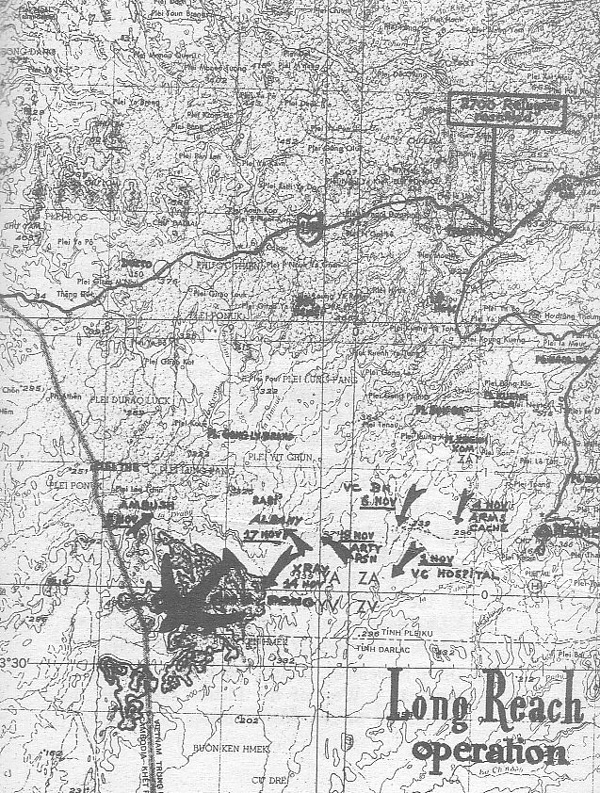
All the Way From Pleime to Chupong
On 27 October, Eagle Flights from the Air Cavalry Division went into action. From dawn to darkness, they flew unwarily over the area to search for the enemy. Every suspect enemy presence is carefully checked and dealt with, either by airstrikes or by the Eagle Flights themselves, or by reaction forces. These tactics compelled the enemy to move continuously, to disintegrate and to fragment into small parties and thus they could not avoid being sighted.
Numerous VC stragglers had been captured through this process but it was only five days later that the first notable results were gained.
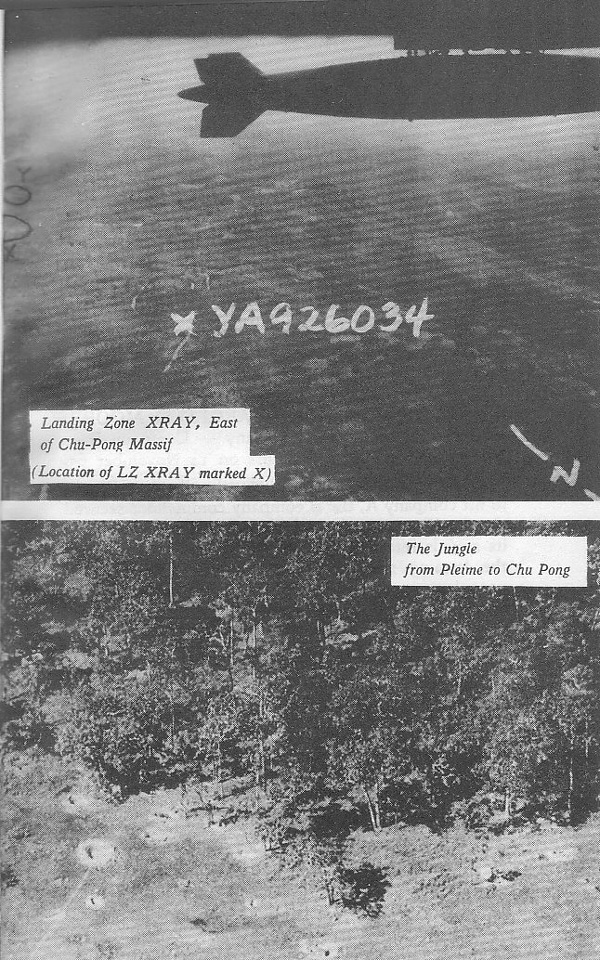
On 1st November 1965, at 0730 hours, about a VC platoon was sighted at 10 km South West of the Pleime Camp. A reaction force was immediately sent by the 1st Brigade of the 1st Air Cavalry Division. Only minutes after, 20 VC were killed and 19 captured. Friendly troops kept on searching and suddenly discovered a VC field hospital well equipped with medicines and surgical instruments made by Communist countries. All the communist origin supplies were still brand-new and amounted approximately to a value of 40000 US dollars.
While the evacuation of the trophy was carried out by helicopters, a battalion size enemy force stealthily moved toward friendly troops and strove to surround their positions. The first engagement between elements of the 1st US Air Cavalry Division and the VC took place. It lasted for five hours until darkness. When the enemy finally broke contact and withdrew, it had been for them a deadly blow by the "First Team": 99 VC were killed (Body count), 44 other VC regulars captured along with 40 weapons. But at least more than 200 other VC were probably killed and wounded.
The capture of the aid station was a major find for the Air Cavalry Division and besides the opportunity it provided for destruction of VC forces, it also yielded documents, including one particularly valuable map that revealed enemy supply and march routes. These, in turn were converted into intelligence that led to further successes:
Up to this point, the 1st Brigade of the First Air Cavalry Division in its "All the Way" (2) deployment over an area of about 2500 square kilometers had given severe blows to the withdrawing VC units but through the contacts made and related above, no traces were yet found concerning the 32nd Regiment. Although the number of VC casualties amounted to 1500, including those suffered in the first phase, one more regiment - the 66th Regiment - had been added to the enemy order of battle.
There was strong suspicion that elements of the 32nd Regiment may have slipped off to the east.
On 9 November, the movement and shift in emphasis from west to east commenced and on 10 November, the US 3rd Brigade relieved the US 1st Brigade.
But in reality, the VC units were located by that time in the following places, as proved later on by subsequent operations launched into the very heart of the Chu Pong-Ia Drang complex:
Convinced that friendly forces had lost tracks of its units, VC Field Front quickly made a decision to regain its advantage with an attack. The target again was Pleime and the date of attack set at 16 November. The plan was known within the VC ranks as the second phase of the attack of Pleime. All the three regiments would be committed this time as well as a battalion of 120mm mortars and a battalion of 14.5mm twin-barrel anti-aircraft guns which were both en route down the infiltration trail and scheduled to arrive in time for the attack. According to the declaration of a surrendered political officer, the scheme of the new attack would have as primary objective the destruction of the camp.
The VC Suicide, 14 November 1965
But the above plan would never be carried out because only some days later, the 3rd Brigade resumed pushing west. (Operation Silver Bayonet).
At noon on 14 November, helicopters disgorged troops and artillery from the 1st Air Cavalry on the very doorsteps of the Chu Pong mountains. Instead of launching an attack
After a 20-minute tube artillery preparation, and 30 seconds of aerial artillery fire, the landing of the 1/7 Cavalry battalion began. The battalion commander, Lieutenant Colonel Harold G. Moore, himself with the assault company - Company B - landed precisely at 1048 hours on 14 November 1965.
While the helicopters were shuttling back to Pleime to lift company A, the B company commander secured the landing zone by having one platoon dispatch its squads into different areas, 50 to 100 meters off the landing zone to reconnoiter. At approximately 1120 hours a prisoner was taken. He stated that he had eaten only bananas for five days and that there were three VC battalions on the mountain.
At 1210 hours, as sufficient elements of company A had landed, the LZ security mission was given to that company and company B ordered to search the lower portion of the mountain area with emphasis on the finger leading down towards X-ray.
Around 1245 hours, lead elements of company B began to engage in a fire fight of moderate intensity. Shortly afterwards, at approximately 1330 hours, the company commander reported that he was being attacked heavily by at least two companies of enemy and that his right platoon 2B1/7 was in danger of being surrounded and cut off from the rest of the company by a numerically superior force. The fire fight became intense. Also a few rounds of 60 and 81 mm mortar fire began falling in the LZ and on company B.
Shortly after the fire fight began, the last platoon of company A and lead elements of company C landed. Company A was then ordered to move up on the left of company B, to establish physical contact with it, to protect its left flank and to send one platoon up to assist company B in getting to the platoon which was in danger. Company C was ordered to take up a blocking position off the landing zone to the south and southwest to prevent the LZ from being overrun in that direction and to give protection to A company's left flank. Airstrikes and artillery fires were called in on the lower fringe of the mountains foothills and work over the mountain and enemy approaches to the LZ from the west and south. But there were no well-defined terrain features to help and the scrubs and trees all looked alike. The air was heavy with smoke and dust. The fact that the separated 2B1/7 platoon was forward of companies A and B delayed delivery of effective fires in support of these two companies. However, using the technique of "walking" fires down the mountain from the south and west, fires were placed where they gave some help to these two companies. Despite all its efforts, company B reinforced was only able to get to within 75 meters of the cut-off platoon and could get no further.
Concurrently, company A minus also made heavy contact with a large force of at least one enemy company which was driving in and along a dry creek bed parallel to the western edge of the LZ. A very heavy firefight immediately broke out. Company A was taking light casualties and extracting a heavy toll from the enemy. One platoon was in such a position that it was able to bring close-in flanking fire on 50-70 VC as they continued moving across their front.
Just as company A firefight broke out, the last elements of company C and the lead elements D landed. The C company commander directed his elements into position alongside his other elements which had landed previously within five minutes, a force of 175-200 enemy headed for the LZ and ran headlong into company C. They were held off and numerous of them killed in the process of trying to get to the landing zone. The action continued for approximately one hour and a half until the enemy, disorganized and decimated, pulled off under heavy friendly artillery and air fires, dragging many of his dead and wounded.
At 1500 hours, as the remainder of the tactical elements of the battalion finally landed, and the enemy fire had slacked off, due to companies C and D actions, the battalion commander could quickly give necessary orders for the repositioning of his troops. Afterwards, two attacks were launched to reach the surrounded 2B1/7 platoon. But they were met by a greatly superior enemy force which from concealed positions was trying to cut off the attacking forces into parts. By 1740 hours, Colonel Moore decided to pull back companies A and B under cover of heavy supporting fires to the fringe of the landing zone and set up a tight defensive perimeter for the night. The battalion was still in good communications with the surrounded platoon and it was ringed with close in artillery defensive fire. By 1800 hours, company B of the 2/7 battalion landed to reinforce the 1/7.
15 November 1965
Due to the heavy losses they had received in the afternoon, the enemy made only some light probes around the perimeter at night. As for the cut-off platoon, it received three separate attacks from the enemy but thanks to the protection by continued close-in artillery fires, when daylight broke, numerous enemy dead were seen around the platoon.
But as first light came, the enemy reappeared and simultaneously attacked from three directions: from the south, south west and south east. By 0730 hours, the enemy had
At approximately 0910 hours, company A, 2/7 battalion landed to reinforce. By 1000 hours, the enemy attack was finally repelled, enemy corpses, body fragments, weapons and equipment were littered in profusion around the edge and forward of the perimeter. There was massive evidence of many other enemy dead and wounded being dragged away from the area.
The relief of the cut-off platoon took place in the afternoon and was conducted by the 2/5 battalion which had been sent by the 3rd Brigade and on foot from LZ Victor, had closed into LZ X-ray at 1205 hours. Little enemy resistance was encountered and the platoon was reached at 1510 hours. It still had ammunitions left, was in good morale and suffered only 8 KIA, 12 WIA.
16 November 1965
The night was relatively quiet until 0400 hours when a force of 250-300 enemy attacked from the south east. Flareship illumination was called for and continuous until 0545 hours. The attack was beaten off by small arms and artillery fires. At 0432 hours,
A search and clear sweep was conducted at 0810 hours by all units on the perimeter. Enemy dead were lying throughout the area and numerous weapons were collected.
The entire battle had lasted continuous for 48 hours and the enemy had suffered at X-ray almost one third of their total losses throughout all three phases:
As for the 1/7 battalion, 79 troops were killed and 125 wounded.
The ratio which amounts to 1/10 has proved how lucky the 1/7 battalion had been because it was rather surprising that from the hills which dominate the LZ, the enemy did not position any crew-served weapons to support their attack. Such a situation could be explained only by the following reasons:
The 1/7 battalion left LZ X-ray at 1040 hours on 16 November and was replaced by the 2/7 and 2/5 battalions.
17 November 1965
It is worth mentioning that since the afternoon on 15 November, the B52
stratofortresses had also taken part in the battle with five daily bombardments of the Chu Pong massif. On 17 November, the targets also included LZ X-ray and the two friendly battalions were so ordered to move 3 km away from the LZ, northward and northwestward to another called LZ Albany.
The displacement was also based on the estimate that the enemy had withdrawn in that direction. In the afternoon of the previous day, a friendly helicopter had been shot down over that area, the enemy movement could also aim at attacking the artillery position east of X-ray which had provided effective support to the 1/7 battalion during the last two days. The two battalions moved into different directions, the 2/7 northward and the 2/5 northwestward.
The first battalion fell afterwards into a VC ambush conducted by a battalion-size enemy unit, when it almost came near its objectives.
But once again, the VC had offered themselves as targets for air-strikes and artillery fire:
On 18 November, an attack was conducted against the artillery position, resulting with approximately 200 VC KIA and 20 more weapons captured.
Decimated by successive failures and losses and the base of Chu Pong being destroyed by B52's, the VC finally gave up their attempts and dispersed into small groups, they withdrew in the direction of the border.
Major General Vinh Loc
 on Pleime, field Front fount itself engaged in a struggle to defend its own base. The landing zone called L.Z. X-ray was about 25 km from the Camp of Pleime, at the eastern foot of the Chu Pong massif. The terrain was flat and consisted of scrub trees up to 100 feet high, thick elephant grass varying in height from one foot to five feet and ant hills throughout the area up to eight feet high with thick brush and elephant grass on and around them. Along the western edge of the LZ, the trees and grass were especially thick and extended off into the jungle on the foothills of the mountain.
on Pleime, field Front fount itself engaged in a struggle to defend its own base. The landing zone called L.Z. X-ray was about 25 km from the Camp of Pleime, at the eastern foot of the Chu Pong massif. The terrain was flat and consisted of scrub trees up to 100 feet high, thick elephant grass varying in height from one foot to five feet and ant hills throughout the area up to eight feet high with thick brush and elephant grass on and around them. Along the western edge of the LZ, the trees and grass were especially thick and extended off into the jungle on the foothills of the mountain.
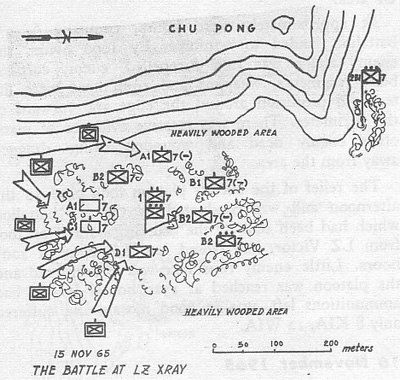 moved almost to the perimeter foxholes despite taking severe losses from artillery, mortar and close air support. There was considerable hand fighting. At 0755 hours, all platoon positions were ordered to throw a colored smoke grenade to define visually for the air observers the periphery of the perimeter and all fire support brought in extremely close, because the enemy fire was so heavy that movements toward or within the sector of defense resulted in more friendly casualties. Some friendly artillery fire fell inside the perimeter itself and two cans of napalm were delivered in the battalion CP area.
moved almost to the perimeter foxholes despite taking severe losses from artillery, mortar and close air support. There was considerable hand fighting. At 0755 hours, all platoon positions were ordered to throw a colored smoke grenade to define visually for the air observers the periphery of the perimeter and all fire support brought in extremely close, because the enemy fire was so heavy that movements toward or within the sector of defense resulted in more friendly casualties. Some friendly artillery fire fell inside the perimeter itself and two cans of napalm were delivered in the battalion CP area.
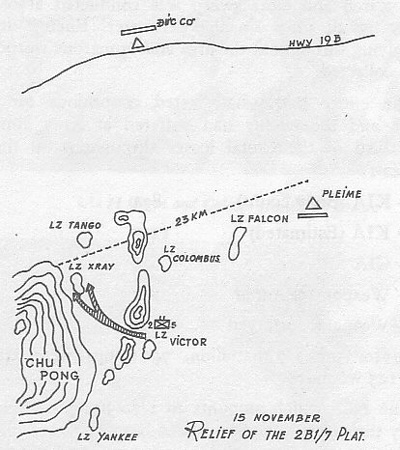 another attack by 200 enemies came in from the same direction but the artillery took a heavy toll. By 0500 hours, the weight of the enemy attack had shifted more to the southwest but repulsed half an hour later. At 0627 hours, another attack came directly toward the CP. At 0641 hours, the enemy had been beaten off and was dragging off bodies under fire.
another attack by 200 enemies came in from the same direction but the artillery took a heavy toll. By 0500 hours, the weight of the enemy attack had shifted more to the southwest but repulsed half an hour later. At 0627 hours, another attack came directly toward the CP. At 0641 hours, the enemy had been beaten off and was dragging off bodies under fire.
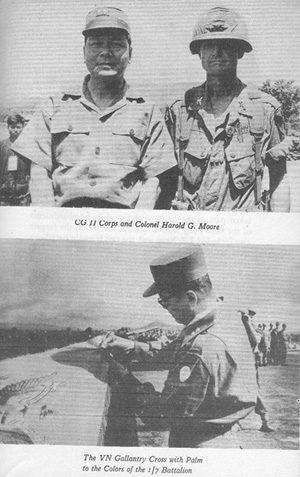
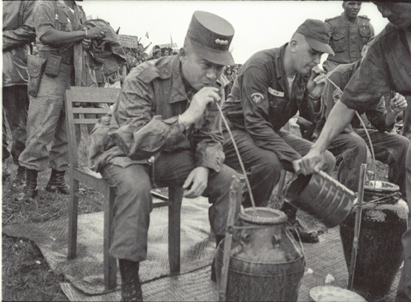
(1) After the testing period which started in 1963, the Division was officially activated in June 1965 and came to Viet Nam in September 1965. In comparison with the other US Divisions, the 1st Air Cavalry has less troops (15787 instead of 15900) and vehicles (1600 instead of 3200) but more aircraft (435 instead of 101). The displacement of 3000 troops over a distance of 160 km takes only 59 minutes (US Army Information Digest, August 65, page 36)
(2) Name of the operations conducted by the Brigade.
Colonel Hieu, ghostwriter
(Why Pleime - April 1966)